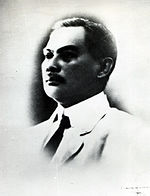Arsenio Cruz-Herrera
| Arsenio Cruz Herrera | |
|---|---|
 |
|
| Mayor of Manila | |
|
In office August 7, 1901 – September 18, 1905 |
|
| Vice Mayor | Ramón J. Fernández (1901-1904) |
| Preceded by | post created |
| Succeeded by | Félix Roxas |
| Member of the 3rd Philippine Legislature from Rizal's First District | |
|
In office October 16, 1912 – February 24, 1916 |
|
| Preceded by | Jose Lino Luna |
| Succeeded by | Arcadio Santos |
| Assistant Secretary of Interior of the First Philippine Republic | |
|
In office 1899–1901 |
|
| President | Emilio Aguinaldo |
| Personal details | |
| Born |
December 14, 1863 Tondo, Manila, Captaincy General of the Philippines |
| Died | April 8, 1917 (aged 53) |
| Political party | Progresista Party (1907-1914) |
| Other political affiliations |
Democrata Party (1914-1916) |
| Spouse(s) | Julita Alejandrino (1888-1912), Bernarda Sastre (1912-1917) |
| Children | Jose, Rosario, Miguel, Concepcion, Augustin, Natividad, Augusto, and Emmanuela Cruz-Herrera |
| Alma mater | Colegio de San Juan de Letran, (AB, 1880); University of Santo Tomas, (1889, 1892) |
| Profession | Lawyer |
| Military service | |
| Allegiance |
|
| Battles/wars | Philippine Revolution |
Arsenio Cruz Herrera (December 14, 1863 – April 8, 1917) was considered the first Filipino mayor of Manila. He was also the leader of the Progresista Party from 1907 to 1914.
Arsenio was born on December 14, 1863 in Tondo, Manila. His parents were Tomás Cruz and Ambrosia Herrera. He studied in a school under Fortunato Jacinto, then at Colegio de San Juan de Letran where he received a degree of bachiller en artes (Bachelor of Arts) in 1880. He later enrolled at the University of Santo Tomas to attain a licentiate in canon law (1889) and jurisprudence (1892). At the University of Santo Tomas, he studied while working at the university library. He was able to start his own law office right after graduating, a firm where Juan Sumulong and Rafael Palma were later able to work as young lawyers. His law practice earned as much as eighty thousand pesos per year.
Little was known about his activities during the Philippine Revolution. According to Manuel Artigas, he advised General Maximo Hizon on the capture of Angeles, Pampanga. After the return of Emilio Aguinaldo in the Philippines, Cruz Herrera together with Ambrosio Rianzares and Felipe Buencamino.
Cruz Herrera was offered the post as War Director of the new revolutionary government, a responsibility he refused to take. Antonio Luna was made War Director instead. Cruz Herrera rather chose to manage the official government newspaper, the El Heraldo de la Revolución. His efforts made the revolutionary government to establish the Universidad Cientifico-Literaria de Filipinas in 1899, where he taught law. During the Malolos Congress, he was elected as one of the four congress members of Manila. He was also part of the commission that drafted the Malolos Constitution, which was enacted on January 21, 1899. He later realized that the armed struggle for independence was vain, so he decided to cooperate with the Americans.
...
Wikipedia
